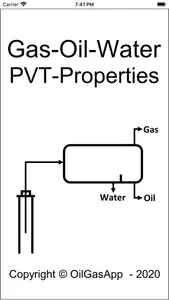Oil&GasPVT calculates physical properties for gases (Natural Gas, Air and Nitrogen) and liquids (Crude Oil, Water, Methanol (MeOH), Mono-ethylene Glycol (MEG), Di-ethylene Glycol (DEG) and Tri-ethylene Glycol (DEG)):
Gas properties:
- Compressibility factor (Z-factor - gas deviation factor)
- Molecular weight
- Density
- Viscosity
- Thermal compressibility
- Thermal conductivity
- Specific heat capacity
- Ideal heat capacity ratio, Cp/Cv
- Real isentropic coefficient, k
- Gas formation volume factor (natural gas only)
- Pseudo Critical properties
- Pseudo Reduced properties
For natural gas the choice of method for calculating Z-factor (compressibility factor) also determines method for calculating isothermal compressibility, formation volume factor, specific heat capacity and isentropic coefficient (ideal and real). For air and nitrogen the Redlich-Kwong equation of state is used.
Liquid properties:
- API gravity (Crude Oil only)
- Molecular weight
- Density
- Viscosity
- Thermal compressibility
- Thermal conductivity
- Specific heat capacity
- Surface tension
- Bubble point pressure
- Solution Gas-Oil-Ratio (oil and water)
- Formation Volume Factor (oil and water)
- Pseudo Critical properties
- Pseudo Reduced properties
For crude oil the user can select different empirical correlations for density, viscosity, formation volume factor (which also determines method for calculating bubble point pressure and solution gas-oil ratio) and surface tension. For water, different options are available for calculating solution-gas-water ratio, water viscosity and formation volume factor water.
Gas properties:
- Compressibility factor (Z-factor - gas deviation factor)
- Molecular weight
- Density
- Viscosity
- Thermal compressibility
- Thermal conductivity
- Specific heat capacity
- Ideal heat capacity ratio, Cp/Cv
- Real isentropic coefficient, k
- Gas formation volume factor (natural gas only)
- Pseudo Critical properties
- Pseudo Reduced properties
For natural gas the choice of method for calculating Z-factor (compressibility factor) also determines method for calculating isothermal compressibility, formation volume factor, specific heat capacity and isentropic coefficient (ideal and real). For air and nitrogen the Redlich-Kwong equation of state is used.
Liquid properties:
- API gravity (Crude Oil only)
- Molecular weight
- Density
- Viscosity
- Thermal compressibility
- Thermal conductivity
- Specific heat capacity
- Surface tension
- Bubble point pressure
- Solution Gas-Oil-Ratio (oil and water)
- Formation Volume Factor (oil and water)
- Pseudo Critical properties
- Pseudo Reduced properties
For crude oil the user can select different empirical correlations for density, viscosity, formation volume factor (which also determines method for calculating bubble point pressure and solution gas-oil ratio) and surface tension. For water, different options are available for calculating solution-gas-water ratio, water viscosity and formation volume factor water.
Show More




